What is Snowmobiling’s Next Big Thing?
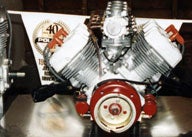
We take a guess at what the snowmobiling future may hold
This summer, as the Snowmobile.com Mountain Team sat in our tractors or rode our bikes, we ran the numbers and stroked the crystal ball to decipher what will be the next big I-never-saw-that-coming product. So, with a box of 64 Crayola crayons, we began sketching out what we may see in five years or so. We claim no hidden knowledge nor give any guarantees.
But first, some example innovations that either flashed up and burned out or proved timely and enduring to benefit the mountain snowmobiler. Many next big ideas were first conjured up by aftermarketeers, such as Advanced Turbo Systems, Simmons, Starting Line Products, and USI, to name a few. We must not forget these pioneers who advanced snowmobiling power, travel and handling to the benefit of us all.
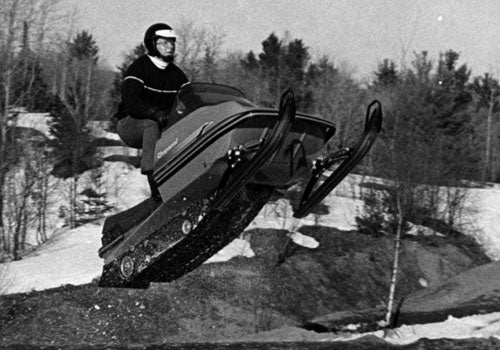 Although it has a short life span, the 1974 Chaparral SX brought high performance liquid-cooled engine performance to snowmobiling.
Although it has a short life span, the 1974 Chaparral SX brought high performance liquid-cooled engine performance to snowmobiling.Arctic Cat in the 1970s introduced to the snowmobiling masses two firsts: an aluminum belly pan and slide rails for the rear suspension. This was good engineering to lighten a snowmobile and to make it glide along the snow with less track resistance. Only the slide rail concept survived amongst all the OEMs; aluminum gave way to ultra-high molecular plastics for the belly pan.
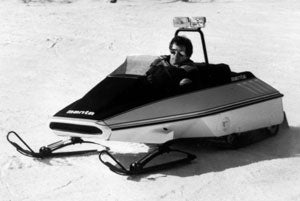 Not all snowmobile concepts became the “next big thing,” such as this sit-in, rear-engined, twin-tracked Manta.
Not all snowmobile concepts became the “next big thing,” such as this sit-in, rear-engined, twin-tracked Manta.Raider in the 1970s, Manta in the 1980s, and Trail Roamer in 2000 brought their twin track snowmobiles to the snow; plausible concept for the trails, but not good for the mountains. The twin track concept never gained footing for the trail segment, let alone the mountain segment.
Independent front suspension was birthed by Polaris (some say Arctic Cat) and mass produced on its Trail Indy. Making an exit were leaf springs on skis giving way to trailing arms, telescopic struts and A-arms – with A-arms the final choice for the OEMs. Independent front suspension was a next big thing in the early 1980s.
In the late 1980s and early 1990s, the Hibberts, Rex and Kirk from Driggs, Idaho, bolted on Fox Shocks to their Arctic Cat EXTs to better handle the craters in the Rocky Mountain Cross Country Race Circuit (RMXCRC). From these two Idaho farm boys, high-pressure gas shocks began a quick download onto fast trail sleds and eventually mountain snowmobiles; this was a next big thing that survived.
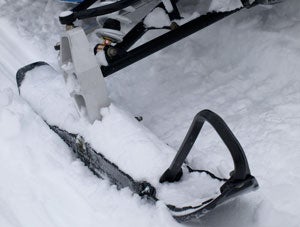 Moving from steel skis to lighter weight plastic skis took a bit of time, but try to find a sled with steel skis nowadays.
Moving from steel skis to lighter weight plastic skis took a bit of time, but try to find a sled with steel skis nowadays.Plastic skis were truly revolutionary. This little concept appeared first as a bolt-on underside-skin to existing metal skis, then second as a full-molded product. Ultra-high molecular weight (UHMW) plastic skis came and to this day remain a constant for both trail and mountain snowmobiles.
Electronic fuel injection, introduced by Polaris with its RXL and Ski-Doo on its Formula EFI, changed for the mountain rider how fuel flowed and atomized for thin high-altitude air. But, EFI had to go through many growing pains. Micro-computer chips, programming and fuel mapping had to mature and be tested year-in and year-out by the hardest riders – the mountain riders who subject their snowmobiles to harsh, thin cold air and deep snow conditions at wide open throttle. EFI is great, but it took much work and patience to arrive where it is today.
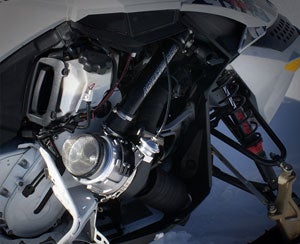 By pioneering a turbo system specifically for Ski-Doo’s direct injection E-Tec engines, Aerocharger Turbo Systems of New Century, Kansas brings high horsepower to mountain riders hungry for low weight performance. (Image courtesy of Aerocharger LLC)
By pioneering a turbo system specifically for Ski-Doo’s direct injection E-Tec engines, Aerocharger Turbo Systems of New Century, Kansas brings high horsepower to mountain riders hungry for low weight performance. (Image courtesy of Aerocharger LLC)The Karpik brothers and their company, FAST, delivered long travel, uncoupled suspensions to the trail rider and racer. These suspensions uprooted rear suspension travel and gave it new life. Soon FAST suspensions were appearing on 121-inch snowmobiles in large numbers. Shortly thereafter, Polaris began building its XLTs and XCRs with Xtra-10 long-travel rear skids. Initially these were great on the trails, but did not float a chassis well in deep powder. Engineering, however, never rested and now all snowmobiles benefit from this idea that incubated at FAST.
Ski-Doo brought two critical changes which were huge boons to the mountain rider, equal to EFI. First was the long track, specifically the 151 Summit X from 2000. Second was rider forward position from the 2003.5 and 2004 REV Summit. These two designs were the next big thing in that decade, 2000 through 2010. The rider forward concept, like long travel suspensions, had to evolve but the long track concept rapidly gained traction.
AD Boivin and its single-ski motorcycle-like snowmobile, the Snow Hawk, introduced to the trail and later the mountain segment a radical concept to snowmobiling that developed a small following. The front and rear suspensions were noteworthy, making the snowbike idea a plausible concept. But, after several years of trying to recoup R&D costs through sales, the Snow Hawk did not build a deep fan base and died. Perhaps the concept still lingers. More later.
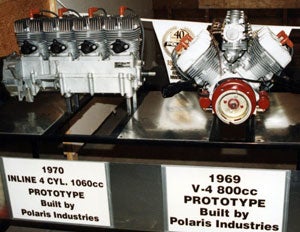 Over the years engineers have conjured up all sorts of snowmobile power plants to include inline two-stroke fours as well as vee-fours. With direct injection, turbocharging and computerization, maybe there will be a new next big thing in engine development.
Over the years engineers have conjured up all sorts of snowmobile power plants to include inline two-stroke fours as well as vee-fours. With direct injection, turbocharging and computerization, maybe there will be a new next big thing in engine development.One last, it-may-have-been-the-next-big-thing was an off-road company in California that built a snowmobile called Redline. The southern California company had innovations that were unique for suspension travel, motor and driver position. The product gained investor funds, but heavy production never became a reality. However, Redline’s concepts challenged traditional OEM thinking. The OEMs did benefit in small manner from Redline’s concepts.
Now, many other little revolutionary events occurred, such as mechanical altitude-adjusting carburetors, and we understand that, but space will not allow us to cover all. For now, let’s guess what the next big mountain concept may be from all the aforementioned.
A winter’s season ago, I spent time on several Timbersled Mountain Horse snowbikes. Timbersled, an Idaho-based leading suspension aftermarket company, modified and adapted its long-travel rear suspension to a dirt bike chassis, such as a Honda CRF 450 or Yamaha YZF 450. To make it travel in snow, the front fork has an adapter that makes the bike wear a ski. Bottom line, there may be a future for a non-runningboard, footpegs-only snowmobile. I don’t foresee a future where two skis give way to one, but I do see a future were an OEM may drop runningboards for a tunnel design that has footpegs. This would virtually eliminate the chassis from being hung up on deep snow.
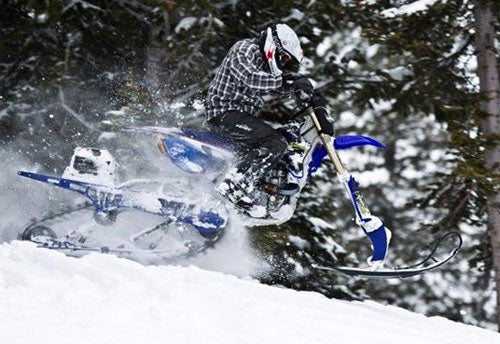 AD Boivin brought the concept of a snow bike into production, but Idaho-based Timbersled Mountain Horse snowbike takes the idea to the mountains with kits that make its snow bikes about 200 pounds lighter than a sled. The company claims that its snowbikes offer handling that is much more accurate than a sled and allow the rider to sneak between trees and across narrow snow bridges. And, the snowbike features pegs, not runningboard, which can get hung in deep snow. (Image courtesy of TimberSled)
AD Boivin brought the concept of a snow bike into production, but Idaho-based Timbersled Mountain Horse snowbike takes the idea to the mountains with kits that make its snow bikes about 200 pounds lighter than a sled. The company claims that its snowbikes offer handling that is much more accurate than a sled and allow the rider to sneak between trees and across narrow snow bridges. And, the snowbike features pegs, not runningboard, which can get hung in deep snow. (Image courtesy of TimberSled)Now, this would be a huge engineering hurdle, given the mountain rider wants to sidehill and highmark, which runningboards and the front suspension allow, but the Snow Hawk and Timbersled’s Mountain Horse snowbike give us a “perhaps” and a “maybe.”
How about small two-strokes with a turbocharger. With Ski-Doo’s 600. H.O. E-Tec in a Summit and Polaris’ 600 Pro RMK, a marriage between one of these companies and perhaps Boondocker of Idaho Falls, ID could be a next big thing. Pure guess here – no insider information of such. Hear me out. Turbocharged four-stroke snowmobiles are a reality. Yet, these snowmobiles have a cost in weight and price. Perhaps the antithesis to this is a lightweight 600 two-stroke with a mass-produced turbo. The high volume-built turbocharger would keep costs down, and give the consumer a lightweight, fairly inexpensive supersled.
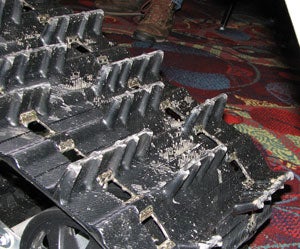 Are we seeing an evolution of track designs that will provide taller and taller paddles for powder riders?
Are we seeing an evolution of track designs that will provide taller and taller paddles for powder riders? As a road bicycle geek, carbon fiber is a wonder product. As manufacturing and smart weaving become more and more available, I predict carbon fiber tunnels, A-arms and engine cradles becoming a truism. Polaris is dabbling in carbon fiber and it may not stop. Chromoly was the ooorah material through the 1990s and into the 21st century, but carbon fiber is becoming the tricktanium of the future.
We may also see paddle tracks growing taller. Arctic Cat has its 2.6-inch paddle track. We believe track paddles will stretch to 2.75 inches, and maybe even taller. These would be reserved for ultra-light supersleds with turbos or carbon fiber.
Again, my bicycle geekness tells me mountain snowmobiles in the near future – maybe – will come equipped with a Garmin-like GPS that will track routes and will feed the routes real time onto a cell phone app like MapMyRide, and will have a built-in ICE-feature (In Case of Emergency) that will ping the wife or local search and rescue if a mishap happens. Also, the GPS can track the rider’s heart rate and caloric burn – just to prove to the naysayers that mountain snowmobile is muscle aching hard work.
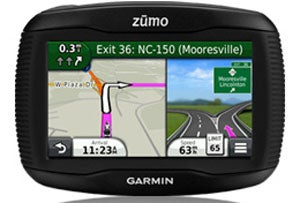 With the popularity of backcountry don’t be surprised to find future sleds that borrow GPS systems similar to ones developed by Garmin for motorcyclists like the Zumo 350LM that features a 4.3-inch sunlight-readable, glove-friendly touch screen display. (Image courtesy of Garmin)
With the popularity of backcountry don’t be surprised to find future sleds that borrow GPS systems similar to ones developed by Garmin for motorcyclists like the Zumo 350LM that features a 4.3-inch sunlight-readable, glove-friendly touch screen display. (Image courtesy of Garmin)How about Flex Fuel or LNG – Liquid Natural Gas. In a world of green, alternative-fuel snowmobiles, four-strokes specifically, may come to a showroom. The technology is there. Who knows? I can only guess.
Could somebody make a two-piece snowmobiles that are easily taken apart (separated into two halves) and easily stored in a pickup bed for quick hauling to a trailhead and fast assembly. I’m just playing with your head. Anyway… what I don’t see happening are diesel-powered snowmobiles, they’d be too dang heavy and fuel gelling would be a problem.
These are just guesses, as I so often stated (I don’t want some blogger or OEM accusing me of insider information), but are possibilities with merit; call it wishful thinking in some cases.
Years ago, I rode Yamaha’s V-Max 4 ST (four cylinder two-stroke) and Polaris’ Xtra-10 equipped XLTs and Storms and thought, “It just can’t get any better.” Look at the industry now. So I continue to guess, wonder and speculate. Wrong, right or indifferent, these are my Star Wars thoughts and surely, you have yours.
Related Reading Inside the Mind of a Snowmobile Test Rider Snowmobile History: Big Money Players Snowmobiling’s Silly Season 7 Things Modern Sledders Won’t Need to Worry About Choosing a Dream Snowmobile Hauler



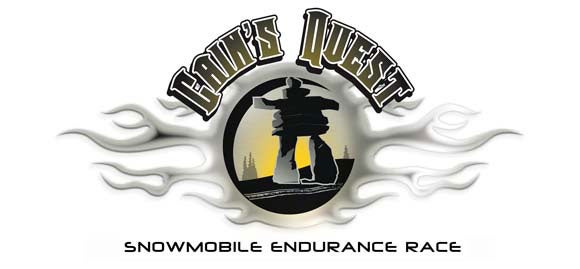
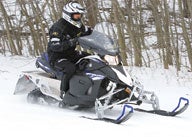
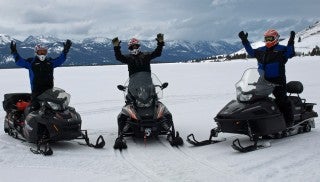


 Your Privacy Choices
Your Privacy Choices